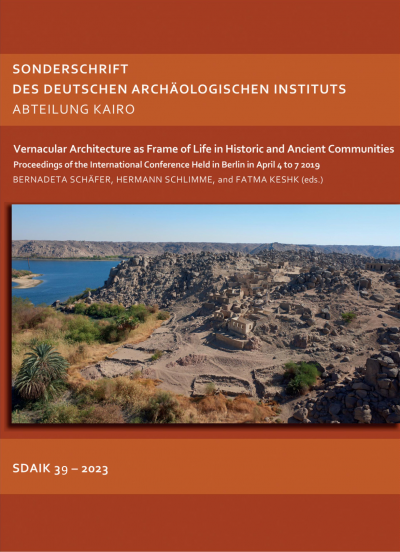Vernacular Architecture as Frame of Life in Historic and Ancient Communities: Proceedings of the International Conference Held in Berlin in April 4 to 7 2019
https://doi.org/10.34780/208v-d8uf
Synopsis
This volume presents a selection of the papers presented at the international conference “Vernacular Architecture as Frame of Life in Historic and Ancient Societies”, held in Berlin in 2019 as part of the DFG-project „Nubian Architecture“. Researchers and experts from all over the world presented and discussed case studies of vernacular architecture from different periods and cultures, with a special focus on Nubia. The academic and artistic examination of vernacular architecture has a long tradition. European vernacular architecture first gained widespread interest during the Romantic period of the 19th century, when it was (mis)understood as the preserver of the „national soul“. Early modernists drew inspiration from vernacular architecture in the Mediterranean. In post-war modernism, the respective domestic vernacular architecture was stigmatised by historically oriented research and musealisation as being bound to the past and backwardness. Since the publications of Bernard Rudofsky and Hassan Fathy at the latest, however, its appreciation as part of the material culture of humanity has been steadily growing. Today more than ever, the aspects of sustainability are coming into focus, and the guiding principles of vernacular architecture can be ground breaking for the necessary turnaround in building practices.
Keywords:
Vernacular architecture, Nubian architecture, NubiaChapters
-
Overview and Reflections
-
Context, Climate, Culture – Traces of Vernacular Architecture in the Travel Notes of the Fourth CIAM
-
The Mediterranean Hill Town and New Habitat – Typologies 1930s to 1980s
-
Vernacular Architecture and Beyond? – The Changing Form and Scale of Buildings and Settlements in the First Millennium BCE Greek World
-
Vernacular Architecture in Late Bronze/Early Iron Age Crete – A Case Study from Kavousi Vronda
-
Flooded Settlements in the Italian Mountains as Consequence of the Construction of Dams – Case Studies and their Relationship with Vernacular Architecture
-
Vernacular Architecture – The Case of the Dogon Country in Mali
-
Physical Structure of Vernacular Settlement and its Related Components in the Village of Maymand
-
The Story of Salma – An Introduction to Studying Vernacular Architecture of Meymand Village Through Narrative
-
Valorizing the Ordinary – Documenting the Vernacular Heritage of Shutb Village
-
House and Household Items in Andaandi and Mattokki Nubian Wise Sayings and Proverbs
-
The Resettlement of the People of Tūmās wa ʿAfya
-
Nubian Vernacular Architecture – A Comparative Study Before and After Displacement in Wadi Halfa, Sudan
-
The Practicality of Nubian Vernacular Architecture
-
Nubian Silver Jewellery – Context and Influences
-
Houses of Bijje Versus Houses of Lower Nubia
-
Vegetation on the Nubian Island of Bigeh – Distribution, Use and Wall Paintings
-
Post-Conference Notes on Re-seeing




